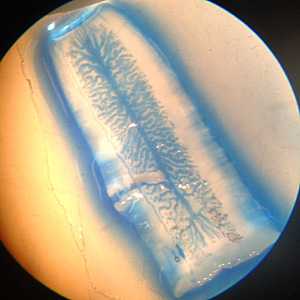
Case #375 - July 2014
An 18-year-old female presented a worm-like object to her primary health care provider, claiming it was found in her stool. She spent two months in Mexico five years prior, and admitted seeing similar objects in her stool over the course of the five years. The specimen was sent to the county public health laboratory for testing. Stool specimens were also collected in 10% formalin for formalin-ethyl acetate (FEA) concentration. Figure A shows the worm-like object after injecting with lactophenol cotton blue. Figure B shows what was observed in low numbers on an unstained wet mount of stool from the FEA concentration; the objects of interest measured 30-34 μm in diameter on average. What is your diagnosis? Based on what criteria?

Figure A

Figure B
Case Answer
This was a case of taeniasis caused by Taenia saginata. Diagnostic morphologic features included:
- mature proglottids with more than 13 primary uterine branches (Figure A).
- eggs (Figure B) within the size range for Taenia spp. that possessed a striated shell and an oncosphere containing hooklets.
More on: taeniasis
Images presented in the monthly case studies are from specimens submitted for diagnosis or archiving. On rare occasions, clinical histories given may be partly fictitious.
DPDx is an education resource designed for health professionals and laboratory scientists. For an overview including prevention and control visit www.cdc.gov/parasites/.
- Page last reviewed: August 24, 2016
- Page last updated: August 24, 2016
- Content source:
- Global Health – Division of Parasitic Diseases and Malaria
- Notice: Linking to a non-federal site does not constitute an endorsement by HHS, CDC or any of its employees of the sponsors or the information and products presented on the site.
- Maintained By:


 ShareCompartir
ShareCompartir